高中16种英语时态总结归纳及其配套练习
16种英语时态总结归纳及练习

时态专题讲解构成时态的助动词be (is, am, are), have (has), shall, will 等需根据主语的变化来选择。
时态是英语中一个重要的语法范畴,它表示不同时间发生的动作或存在的状态以及动作发生或存在的方式。
动作发生的时间可分为现在、过去、将来和过去将来四种形式,动作发生的方式可分为一般、完成、进行和完成进行四种形式。
将时间形式和动作方式结合起来,就构成了以下一般完成进行完成进行现在一般现在时do 现在完成时have done现在进行时is doing现在完成进行时have been doing过去一般过去时did 过去完成时had done过去进行时was doing过去完成进行时had been doing将来一般将来时will do 将来完成时will have done将来进行时will be doing将来完成进行时will have been doing过去将来过去将来一般时would do过去将来完成时would have done过去将来进行时would be doing过去将来完成进行时would have beendoing英语的时态是靠动词的变化和时间状语来表达的。
英语中的时态共有十六种,但是常考的或较常用的只有9种。
要掌握英语的时态和语态,必须掌握好英语中的助动词(do, be, have)和时间状语这两个核心问题。
一般现在时用法:A) 经常性、习惯性动作。
例:He always helps others. (他总是帮助别人。
)B) 客观事实和普遍真理。
尤其要注意,如果前后文不是一般现在时,则无法保持主句、从句时态一致He said lights goes faster than sound. 他说光比声音传播的快。
C) 表示一个按规定、计划或安排要发生的动作,(仅限于某些表示“来、去、动、停、开始、结束、继续”等的动词)可以与表示未来时间的状语搭配使用。
高考英语16种英语时态(用法+例句)
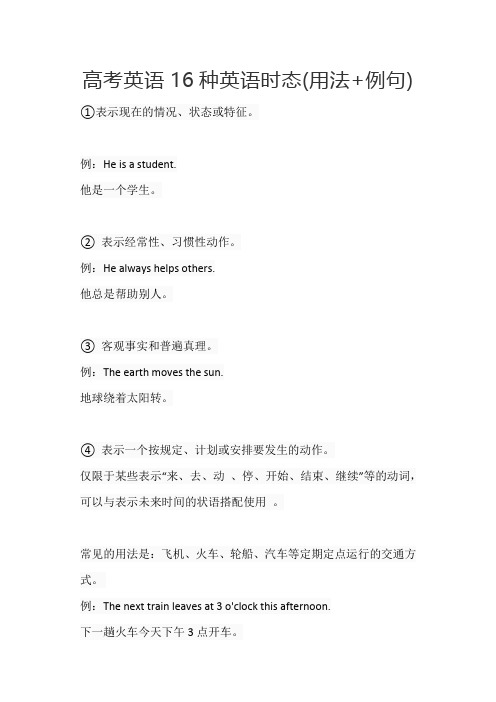
高考英语16种英语时态(用法+例句) ①表示现在的情况、状态或特征。
例:He is a student.他是一个学生。
② 表示经常性、习惯性动作。
例:He always helps others.他总是帮助别人。
③ 客观事实和普遍真理。
例:The earth moves the sun.地球绕着太阳转。
④ 表示一个按规定、计划或安排要发生的动作。
仅限于某些表示“来、去、动、停、开始、结束、继续”等的动词,可以与表示未来时间的状语搭配使用。
常见的用法是:飞机、火车、轮船、汽车等定期定点运行的交通方式。
例:The next train leaves at 3 o'clock this afternoon.下一趟火车今天下午3点开车。
⑤ 在时间、条件和让步状语从句中经常用一般现在(有时也用现在完成时)表示将来的事情。
(即:主将从现原则)例:I will call you as soon as I arrive at the airport.我一到机场就会给你打电话。
When you have finished the report, I will have waited for about 3 hours.等你完成这份报告的时候,我就已经等了将近3个小时了。
2现在进行时(am/is/are doing)①表示此时此刻正在发生的事情。
例:He is listning to the music now.他现在正在听音乐。
② 表示目前一段时间内一直在做的事情,但不一定此时此刻正在做。
例:I am studying computer this term.这个学期我一直在学习计算机。
③ 现在进行时可以表示将来的含义。
a. 瞬时动词的进行一定表将来。
例:I am leaving.我要离开了。
b. 持续动词的进行只有有将来的时间状语或有将来语境中才表将来。
例:I am travelling next month.下个月我要去旅行。
英语16种时态及练习题附答案
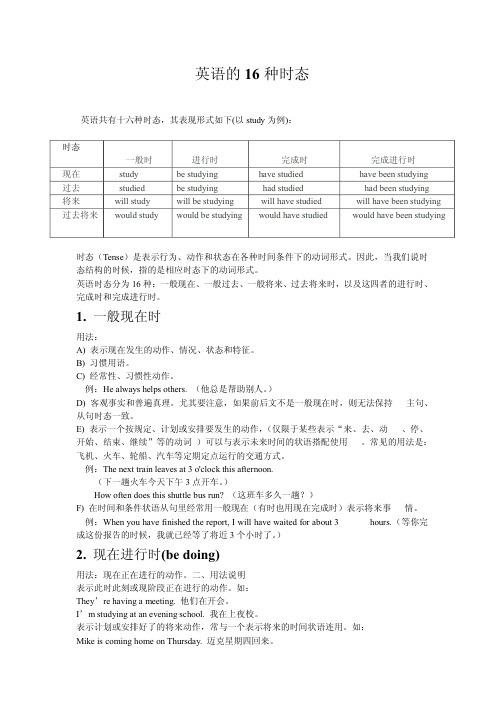
gniod
.gnihtemos er a yehT/uoY/eW .gnik row si tI/ehS/eH .gnivird m a I 式 定 肯
数复词名及 以数复称人三第 和称人二、一第 语 主
�如。气语等烦厌、扬赞示表用连等 reverof ,netfo ,syawla 与时行进在现 。始开半点七会乐音 .03 :7 ta strats trecnoc ehT )„t’nod I 说宜不(。去出备准不我晚今 .gnineve siht tuo gniog ton m’I �较 比试。时在现般一用宜�语主作物事�时行进在现用宜语主作人�事的做要将排安示表�注 。会晚个一开将们他期星下 .keew txen ytrap a gniv ah er’yehT
deiduts evah dluow deiduts evah lliw deiduts dah
gniyduts eb dluow gniyduts eb lliw gniyduts eb gniyduts eb 时行进
yduts dluow yduts lliw deiduts yduts
来将去过 来将 去过 在现 态时
� 。了时小个 3 近将了等经已就我�候时的告报份这成 完你等� .sruoh 3 tuoba rof detiaw evah lliw I ,troper eht dehsinif evah uoy nehW�例 。情 事来将示表�时成完在现用也时有�在现般一用常经里句从语状件条和间时在 )F ��趟一久多车班这� ?nur sub elttuhs siht seod netfo woH � 。车开点 3 午下天今车火趟一下� .noonretfa siht kcolc'o 3 ta sevael niart txen ehT�例 。式方通交的行运点定期定等车汽、船轮、车火、机飞 �是法用的见常。 用使配搭语状的间时来未示表与以可� 词动的等”续继、束结、始开 、停、 动、去、来“示表些某于限仅� �作动的生发要排安或划计、定规按个一示表 )E 。致一态时句从 、句主 持保法无则�时在现般一是不文后前果如�意注要其尤。理真遍普和实事观客 )D � 。人别助帮是总他� .srehto spleh syawla eH�例 。作动性惯习、性常经 )C 。语用惯习 )B 。征特和态状、况情、作动的生发在现示表 )A �法用
完整版)高中16种英语时态总结归纳
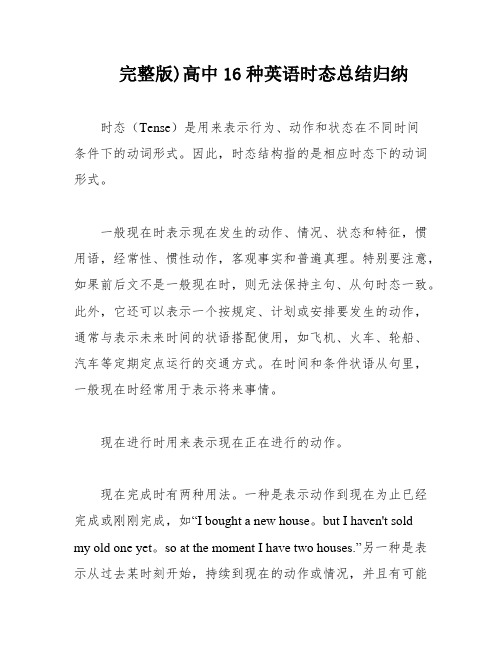
完整版)高中16种英语时态总结归纳时态(Tense)是用来表示行为、动作和状态在不同时间条件下的动词形式。
因此,时态结构指的是相应时态下的动词形式。
一般现在时表示现在发生的动作、情况、状态和特征,惯用语,经常性、惯性动作,客观事实和普遍真理。
特别要注意,如果前后文不是一般现在时,则无法保持主句、从句时态一致。
此外,它还可以表示一个按规定、计划或安排要发生的动作,通常与表示未来时间的状语搭配使用,如飞机、火车、轮船、汽车等定期定点运行的交通方式。
在时间和条件状语从句里,一般现在时经常用于表示将来事情。
现在进行时用来表示现在正在进行的动作。
现在完成时有两种用法。
一种是表示动作到现在为止已经完成或刚刚完成,如“I bought a new house。
but I haven't soldmy old one yet。
so at the moment I have two houses.”另一种是表示从过去某时刻开始,持续到现在的动作或情况,并且有可能会继续延续下去。
这时通常使用延续性动词,时间状语常用since加一个过去的时间点,或for加一段时间,或by加一个现在时间。
4.现在完成进行时 (have been doing)现在完成进行时用来描述一个从过去某一时间开始一直持续到现在的动作或状态,或将继续持续到未来。
例如:我们已经处理这个项目一个多月了,一直在进行中。
5.一般过去时一般过去时用来描述过去某个时间发生的动作或情况,或者过去的惯性动作。
例如:这位老人过去常常坐在公园的长椅上看着别人,一坐就是数个小时。
他以前总是每周看望他的母亲。
在句型中使用 "no sooner than"、"___"、"before"、"r to" 等连接词时,主句要求完成时。
例如:今天之前我从未见过那位教授。
在填空题中,句子中的动作已经持续了一段时间,并且需要进行修理。
16种英语时态总结归纳
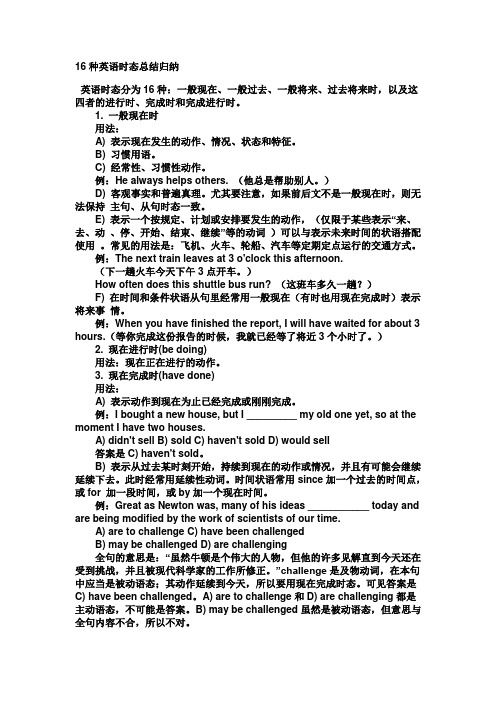
16种英语时态总结归纳英语时态分为16种:一般现在、一般过去、一般将来、过去将来时,以及这四者的进行时、完成时和完成进行时。
1. 一般现在时用法:A) 表示现在发生的动作、情况、状态和特征。
B) 习惯用语。
C) 经常性、习惯性动作。
例:He always helps others. (他总是帮助别人。
)D) 客观事实和普遍真理。
尤其要注意,如果前后文不是一般现在时,则无法保持主句、从句时态一致。
E) 表示一个按规定、计划或安排要发生的动作,(仅限于某些表示“来、去、动、停、开始、结束、继续”等的动词)可以与表示未来时间的状语搭配使用。
常见的用法是:飞机、火车、轮船、汽车等定期定点运行的交通方式。
例:The next train leaves at 3 o'clock this afternoon.(下一趟火车今天下午3点开车。
)How often does this shuttle bus run? (这班车多久一趟?)F) 在时间和条件状语从句里经常用一般现在(有时也用现在完成时)表示将来事情。
例:When you have finished the report, I will have waited for about 3 hours.(等你完成这份报告的时候,我就已经等了将近3个小时了。
)2. 现在进行时(be doing)用法:现在正在进行的动作。
3. 现在完成时(have done)用法:A) 表示动作到现在为止已经完成或刚刚完成。
例:I bought a new house, but I _________ my old one yet, so at the moment I have two houses.A) didn't sell B) sold C) haven't sold D) would sell答案是C) haven't sold。
B) 表示从过去某时刻开始,持续到现在的动作或情况,并且有可能会继续延续下去。
英语十六大时态总结及相关练习题
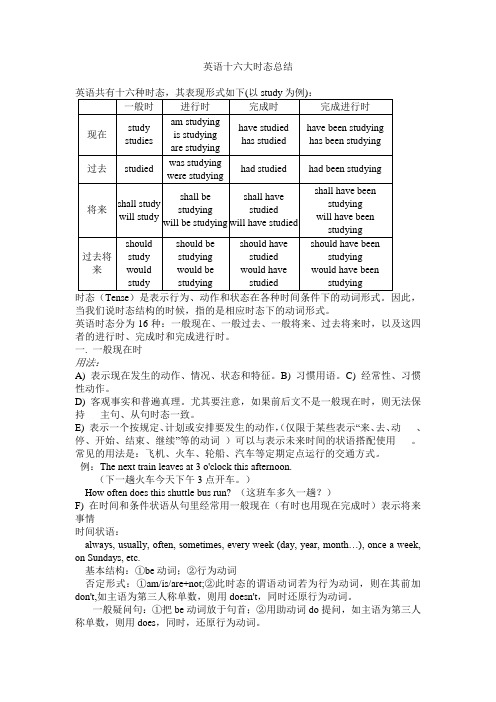
英语十六大时态总结当我们说时态结构的时候,指的是相应时态下的动词形式。
英语时态分为16种:一般现在、一般过去、一般将来、过去将来时,以及这四者的进行时、完成时和完成进行时。
一. 一般现在时用法:A) 表示现在发生的动作、情况、状态和特征。
B) 习惯用语。
C) 经常性、习惯性动作。
D) 客观事实和普遍真理。
尤其要注意,如果前后文不是一般现在时,则无法保持主句、从句时态一致。
E) 表示一个按规定、计划或安排要发生的动作,(仅限于某些表示“来、去、动、停、开始、结束、继续”等的动词)可以与表示未来时间的状语搭配使用。
常见的用法是:飞机、火车、轮船、汽车等定期定点运行的交通方式。
例:The next train leaves at 3 o'clock this afternoon.(下一趟火车今天下午3点开车。
)How often does this shuttle bus run? (这班车多久一趟?)F) 在时间和条件状语从句里经常用一般现在(有时也用现在完成时)表示将来事情时间状语:always, usually, often, sometimes, every week (day, year, month…), once a week, on Sundays, etc.基本结构:①be动词;②行为动词否定形式:①am/is/are+not;②此时态的谓语动词若为行为动词,则在其前加don't,如主语为第三人称单数,则用doesn't,同时还原行为动词。
一般疑问句:①把be动词放于句首;②用助动词do提问,如主语为第三人称单数,则用does,同时,还原行为动词。
二. 一般过去时用法:A) 表示过去某个时间发生的动作或情况。
B) 表示过去习惯性动作。
特别是由would/ used to do表达的句型,本身表示的就是过去时。
He used to visit his mother once a week.(他以前总是每周看望一次他的母亲。
高中英语时态及练习

高中英语时态及练习一、一般现在时1、表示现在发生的动作或存在的状态,常与every day,once a week,in the morning,at present等连用。
例:They don’t usually have enough money to go to the movies.2、表示主语具备的性格和能力等。
例:Mary can speak three languages.3、表示经常性或习惯性的动作,常与always,never,sometimes,often等连用。
例:I never eat fast food.4、表示现在提出的建议或要求。
例:Could you please help me with my math homework?二、现在进行时1、表示正在发生的动作或存在的状态。
例:He is studying for his history exam.2、表示现阶段正在进行的动作,但这个动作不一定正在进行。
例:My brother is preparing for his college entrance exams.3、表示即将发生的动作,常与表示将来的时间副词连用。
例:We are about to start our journey.三、现在完成时1、表示过去发生的动作对现在造成的结果。
例:I have just finished my homework.2、表示过去开始一直持续到现在的动作或状态,并可能继续下去。
例:They have been married for 20 years.四、一般过去时1、表示过去某个时间发生的动作或存在的状态。
例:We saw a movie last night.2、表示过去经常或反复发生的动作。
例:He always went to the park in the morning.高中英语时态练习英语时态是英语语法中非常重要的一个部分,也是我们在学习英语过程中必须要掌握的知识。
(完整版)16种英语时态总结归纳
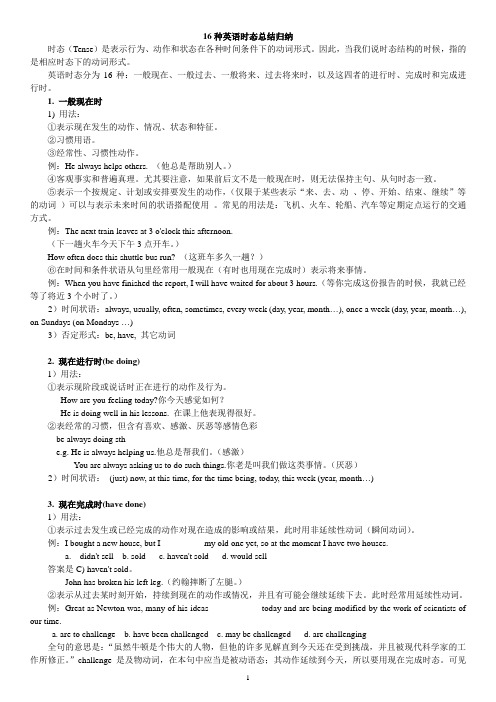
16种英语时态总结归纳时态(Tense)是表示行为、动作和状态在各种时间条件下的动词形式。
因此,当我们说时态结构的时候,指的是相应时态下的动词形式。
英语时态分为16种:一般现在、一般过去、一般将来、过去将来时,以及这四者的进行时、完成时和完成进行时。
1. 一般现在时1) 用法:①表示现在发生的动作、情况、状态和特征。
②习惯用语。
③经常性、习惯性动作。
例:He always helps others. (他总是帮助别人。
)④客观事实和普遍真理。
尤其要注意,如果前后文不是一般现在时,则无法保持主句、从句时态一致。
⑤表示一个按规定、计划或安排要发生的动作,(仅限于某些表示“来、去、动、停、开始、结束、继续”等的动词)可以与表示未来时间的状语搭配使用。
常见的用法是:飞机、火车、轮船、汽车等定期定点运行的交通方式。
例:The next train leaves at 3 o'clock this afternoon.(下一趟火车今天下午3点开车。
)How often does this shuttle bus run? (这班车多久一趟?)⑥在时间和条件状语从句里经常用一般现在(有时也用现在完成时)表示将来事情。
例:When you have finished the report, I will have waited for about 3 hours.(等你完成这份报告的时候,我就已经等了将近3个小时了。
)2)时间状语:always, usually, often, sometimes, every week (day, year, month…), once a week (day, year, month…), on Sundays (on Mondays …)3)否定形式:be, have, 其它动词2. 现在进行时(be doing)1)用法:①表示现阶段或说话时正在进行的动作及行为。
英文学习归纳:英语语法16种时态总结

英文学习归纳:英语语法16种时态总结1. 一般现在时(do/does; is/am/are)①表示现在的情况、状态和特征。
例:He is a student.他是一个学生。
②表示经常性、习惯性动作。
例:He always helps others.他总是帮助别人。
③客观事实和普遍真理。
例:The earth moves around the sun.地球绕着太阳转。
④表示一个按规定、计划或安排要发生的动作。
(常用于列车、客车、飞机或轮船时刻表)例:The next train leaves at 3 o'clock this afternoon.下一趟火车今天下午3点开车。
⑤主将从现:在时间、条件和让步状语从句中经常用一般现在表示将的来事情。
例:If it rains tomorrow, we will stay at home.如果明天下雨,我们会待在家里。
④现在进行时与频度副词连用,表示说话者或褒义或贬义的感情色彩。
例:He is always helping others.他总是帮助别人。
(褒义)④过去进行时和频度副词连用可以表示说话者或褒义或贬义的感情色彩。
例:When he lived in country,he was always helping the poor. 住在乡下时,他总是帮助穷人。
4. 一般将来时①基本结构是will do。
例:We will send her a glass hand-made craft as her birthday gift.我们将送给她一个玻璃的手工制品,作为给她的生日礼物。
②表示“打算…,要…”时,可用am/is/are going to do。
例:This is just what I am going to say.这正是我想说的。
③表示“即将、正要”时,可用am/is/are about to do。
强调近期内或马上要做的事。
16种英语时态总结归纳(热门15篇)
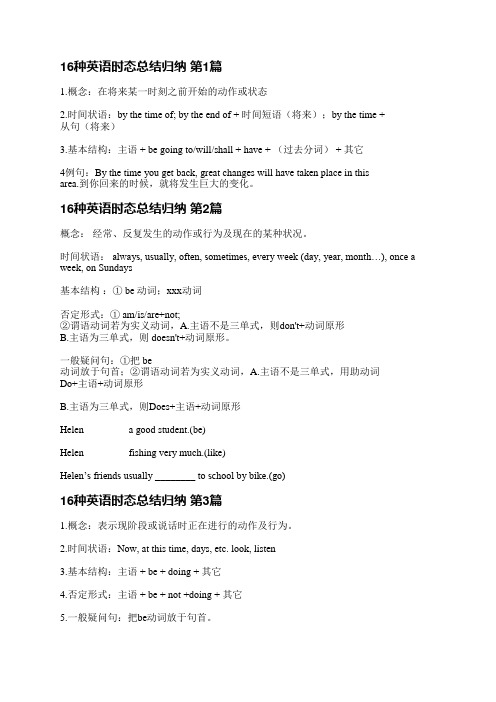
16种英语时态总结归纳第1篇1.概念:在将来某一时刻之前开始的动作或状态2.时间状语:by the time of; by the end of + 时间短语(将来);by the time +从句(将来)3.基本结构:主语 + be going to/will/shall + have + (过去分词) + 其它4例句:By the time you get back, great changes will have taken place in thisarea.到你回来的时候,就将发生巨大的变化。
16种英语时态总结归纳第2篇概念:经常、反复发生的动作或行为及现在的某种状况。
时间状语: always, usually, often, sometimes, every week (day, year, month…), once a week, on Sundays基本结构:① be 动词;xxx动词否定形式:① am/is/are+not;②谓语动词若为实义动词,A.主语不是三单式,则don't+动词原形B.主语为三单式,则 doesn't+动词原形。
一般疑问句:①把 be动词放于句首;②谓语动词若为实义动词,A.主语不是三单式,用助动词Do+主语+动词原形B.主语为三单式,则Does+主语+动词原形Helen ________ a good student.(be)Helen ________ fishing very much.(like)Helen’s friends usually ________ to school by bike.(go)16种英语时态总结归纳第3篇1.概念:表示现阶段或说话时正在进行的动作及行为。
2.时间状语:Now, at this time, days, etc. look, listen3.基本结构:主语 + be + doing + 其它4.否定形式:主语 + be + not +doing + 其它5.一般疑问句:把be动词放于句首。
英语16种时态练习题

英语16种时态练习题英语中的时态是描述动作或状态发生时间的方式。
一共有16种基本时态,它们由三种时态(过去、现在、将来)和四种语态(简单、进行、完成、完成进行)组合而成。
以下是一些练习题,帮助你更好地理解和运用这些时态。
1. 简单现在时(Simple Present):用来描述习惯性动作或普遍真理。
- 练习:He plays soccer every weekend.2. 现在进行时(Present Continuous):用来描述正在进行的动作。
- 练习:She is watching a movie right now.3. 简单过去时(Simple Past):用来描述过去发生的动作或状态。
- 练习:They visited the museum yesterday.4. 过去进行时(Past Continuous):用来描述过去某个时间正在进行的动作。
- 练习:I was reading a book when the phone rang.5. 简单将来时(Simple Future):用来描述将要发生的动作或状态。
- 练习:We will go to the beach next weekend.6. 将来进行时(Future Continuous):用来描述将来某个时间正在进行的动作。
- 练习:He will be working late tonight.7. 现在完成时(Present Perfect):用来描述过去开始的动作对现在有影响或结果。
- 练习:I have finished my homework.8. 现在完成进行时(Present Perfect Continuous):用来描述过去开始的动作一直持续到现在,并且可能还在继续。
- 练习:She has been working on the project for months.9. 过去完成时(Past Perfect):用来描述在过去某个时间点之前已经完成的动作。
高中16种英语时态总结归纳

高中16种英语时态总结归纳高中16种英语时态总结归纳16种英语时态总结归纳时态(Tense)是表示行为、动作和状态在各种时间条件下的动词形式。
因此,当我们说时态构造的时候,指的是相应时态下的动词形式。
英语时态分为16种:一般现在、一般过去、一般将来、过去将来时,以及这四者的进展时、完成时和完成进展时。
1.一般现在时用法:A)表示现在发生的动作、状况、状态和特征。
B)习惯用语。
C)常常性、习惯性动作。
例:Healwayshelpsothers.(他总是帮忙别人。
)D)客观事实和普遍真理。
尤其要留意,假如前后文不是一般现在时,则无法保持主句、从句时态全都。
E)表示一个按规定、规划或安排要发生的动作,(仅限于某些表示“来、去、动、停、开头、完毕、连续”等的动词)可以与表示将来时间的状语搭配使用。
常见的用法是:飞机、火车、轮船、汽车等定期定点运行的交通方式。
例:Thenexttrainleavesat3o“clockthisafternoon.(下一趟火车今日下午3点开车。
)Howoftendoesthisshuttlebusrun?(这班车多久一趟?)F)在时间和条件状语从句里常常用一般现在(有时也用现在完成时)表示将来事情。
例:Whenyouhavefinishedthereport,Iwillhavewaitedforabout3hours.(等你完成这份报告的时候,我就已经等了将近3个小时了。
)2.现在进展时(bedoing)用法:现在正在进展的动作。
3.现在完成时(havedone)用法: A)表示动作到现在为止已经完成或刚刚完成。
例:Iboughtanewhouse,butI_________myoldoneyet,soatthemomentIhavetwo houses.A)didn“tsellB)soldC)haven“tsoldD)wouldsell答案是C)haven “tsold。
英语的16种时态、被动语态和例句分类总结

英语的16种时态,及其被动语态(be + V过去分词)。
1.一般现在时用原形V 或 V+esI often watch TV.我经常看电视。
TV is often watched by me.电视经常被我观看。
2.一般过去时用动词过去时I watched TV just now.我刚才还在看电视。
TV was watched by me just now.电视刚才被我看。
3. 一般将来时 will + 动词原形或be going to + 动词原形I will visit the zoo on Sunday.我星期天要去动物园。
The zoo will be visited by me on Sunday.这个动物园在星期天要被我参观。
(注意这里will可以用is going to代替)4. 过去将来时 would + 动词原形或 was/were going to + 动词原形Yesterday he told me he would visit the zoo next Sunday.昨天他告诉我他下个星期天要去动物园。
Yesterday he told me the zoo would be visited by him next Sunday. (单被动)Yesterday I was told by him the zoo would be visited by him next Sunday. (双被动) (注意,这里would 可以用 was going to 代替)5. 现在进行时 be + vingI am watching TV.我正在看电视。
TV is being watched by me.电视正在被我看。
6. 过去进行时 was/were + vingI was watching TV when you came in.当你进来的时候,我正在看电视。
TV was being watched by me when you came in. 当你进来的时候,电视正在被我看。
高中三年16种英语时态

高中三年16种英语时态高中三年16种英语时态(用法+例句)1一般现在时(do/does; is/am/are)①表示现在的情况、状态或特征。
例:He is a student.他是一个学生。
② 表示经常性、习惯性动作。
例:He always helps others.他总是帮助别人。
③ 客观事实和普遍真理。
例:The earth moves the sun.地球绕着太阳转。
④ 表示一个按规定、计划或安排要发生的动作。
仅限于某些表示“来、去、动、停、开始、结束、继续”等的动词,可以与表示未来时间的状语搭配使用。
常见的用法是:飞机、火车、轮船、汽车等定期定点运行的交通方式。
例:The next train leaves at 3 o'clock this afternoon.下一趟火车今天下午3点开车。
⑤ 在时间、条件和让步状语从句中经常用一般现在(有时也用现在完成时)表示将的来事情。
(即:主将从现原则)例:I will call you as soon as I arrive at the airport.我一到机场就会给你打电话。
When you have finished the report, I will have waited for about 3 hours.等你完成这份报告的时候,我就已经等了将近3个小时了。
2现在进行时(am/is/are doing)①表示此时此刻正在发生的事情。
例:He is listning to the music now.他现在正在听音乐。
② 表示目前一段时间内一直在做的事情,但不一定此时此刻正在做。
例:I am studying computer this term.这个学期我一直在学习计算机。
③ 现在进行时可以表示将来的含义。
a. 瞬时动词的进行一定表将来。
例: I am leaving.我要离开了。
b. 持续动词的进行只有有将来的时间状语或有将来语境中才表将来。
16种英语时态总结归纳-高中

时态(Tense)是表示行为、动作和状态在各种时间条件下的动词形式。
因此,当我们说时态结构的时候,指的是相应时态下的动词形式。
英语时态分为16种:一般现在、一般过去、一般将来、过去将来时,以及这四者的进行时、完成时和完成进行时。
1. 一般现在时(do)基本结构:①be动词;②行为动词否定形式:①am/is/are not;②此时态的谓语动词若为行为动词,则在其前加don't,如主语为第三人称单数,则用doesn't,同时还原行为动词。
一般疑问句:①把be动词放于句首;②用助动词do提问,如主语为第三人称单数,则用does,同时,还原行为动词。
用法:A) 表示现在发生的动作、情况、状态和特征。
B) 习惯用语。
C) 经常性、习惯性动作。
always, usually, often, sometimes, every week (day, year, month…), once a week, on Sundays, etc.例:He always helps others. (他总是帮助别人。
)D) 客观事实和普遍真理。
例:Earth runs around the sun.(地球绕着太阳转)E) 表示一个按规定、计划或安排要发生的动作(仅限于某些表示“来、去、动、停、开始、结束、继续”等的动词)可以与表示未来时间的状语搭配使用。
常见的用法是:飞机、火车、轮船、汽车等定期定点运行的交通方式。
例:The next train leaves at 3 o'clock this afternoon.(下一趟火车今天下午3点开车。
)How often does this shuttle bus run? (这班车多久一趟?)F) 在时间和条件状语从句里经常用一般现在(有时也用现在完成时)表示将来事情。
例:When you have finished the report, I will have waited for about 3 hours.(等你完成这份报告的时候,我就已经等了将近3个小时了。
高考英语十六种时态精讲及练习题附答案
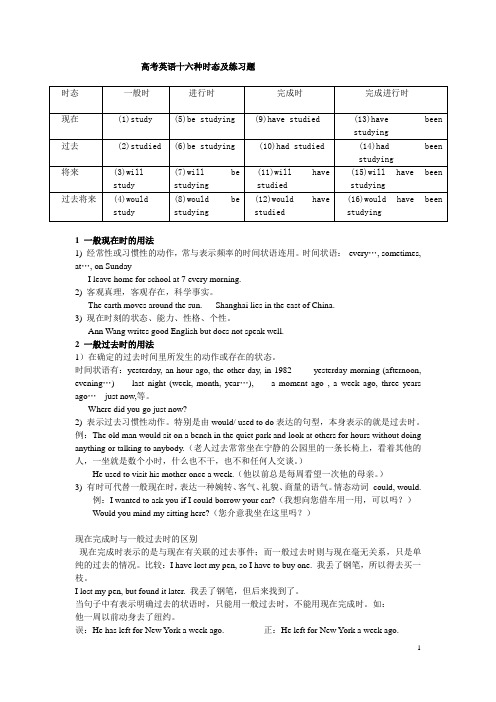
高考英语十六种时态及练习题1 一般现在时的用法1) 经常性或习惯性的动作,常与表示频率的时间状语连用。
时间状语:every…, sometimes, at…, on SundayI leave home for school at 7 every morning.2) 客观真理,客观存在,科学事实。
The earth moves around the sun.Shanghai lies in the east of China.3) 现在时刻的状态、能力、性格、个性。
Ann Wang writes good English but does not speak well.2 一般过去时的用法1)在确定的过去时间里所发生的动作或存在的状态。
时间状语有:yesterday, an hour ago, the other day, in 1982 yesterday morning (afternoon, evening…)last night (week, month, year…), a moment ago , a week ago, three years ago…just now,等。
Where did you go just now?2) 表示过去习惯性动作。
特别是由would/ used to do表达的句型,本身表示的就是过去时。
例:The old man would sit on a bench in the quiet park and look at others for hours without doing anything or talking to anybody.(老人过去常常坐在宁静的公园里的一条长椅上,看着其他的人,一坐就是数个小时,什么也不干,也不和任何人交谈。
)He used to visit his mother once a week.(他以前总是每周看望一次他的母亲。
高中16种英语时态总结归纳及其配套练习

高中 16 种英语时态总结概括及其配套练习( Tense)是表示行、作和状在各样条件下的形式。
所以,当我构的候,指的是相下的形式。
英分 16 种:一般在、一般去、一般未来、去未来,以及四者的行、达成和达成行。
1.一般在A)表示在生的作、状况、状和特色。
B),趣,好等。
C)常性、性作。
He always helps others.D) 客事和广泛真谛。
特别要注意,假如前后文不是一般在,没法保持主句、从句一致。
E)表示一个按定、划或安排要生的作,(限于某些表示“来、去、、停、开始、束、”等的)能够与表示未来的状搭配使用。
常的用法是:机、火、船、汽等按期定点运转的交通方式。
The next train leaves at 3 o'clock this afternoon.How often does this shuttle bus runF) 在和条件状从句里常用一般在(有也用在达成)表示未来事When you have finished the report, I will have waited for about 3 hours.2.在行(be doing)情。
用法:在正在行的作。
3.在达成(have done)A)表示作到在止已达成或达成。
I bought a new house, but I _________ my old one yet, so at the moment I have two houses.A. didn't sellB. soldC. haven't soldD. would sellGreat as Newton was, many of his ideas ___________ today and are being modified by the work of scientists of our time.A. are to challengeB. have been challengedC. may be challengedD. are challengingB.怎样划分达成和去① 在达成是系去和在的。
16种英语时态总结归纳

16种英语时态总结归纳英语时态分为16种:一般现在、一般过去、一般将来、过去将来时,以及这四者的进行时、完成时和完成进行时。
1. 一般现在时用法:A) 表示现在发生的动作、情况、状态和特征。
B) 习惯用语。
C) 经常性、习惯性动作。
例:He always helps others. (他总是帮助别人。
)D) 客观事实和普遍真理。
尤其要注意,如果前后文不是一般现在时,则无法保持主句、从句时态一致。
E) 表示一个按规定、计划或安排要发生的动作,(仅限于某些表示“来、去、动、停、开始、结束、继续”等的动词)可以与表示未来时间的状语搭配使用。
常见的用法是:飞机、火车、轮船、汽车等定期定点运行的交通方式。
例:The next train leaves at 3 o'clock this afternoon.(下一趟火车今天下午3点开车。
)How often does this shuttle bus run? (这班车多久一趟?)F) 在时间和条件状语从句里经常用一般现在(有时也用现在完成时)表示将来事情。
例:When you have finished the report, I will have waited for about 3 hours.(等你完成这份报告的时候,我就已经等了将近3个小时了。
)2. 现在进行时(be doing)用法:现在正在进行的动作。
3. 现在完成时(have done)用法:A) 表示动作到现在为止已经完成或刚刚完成。
例:I bought a new house, but I _________ my old one yet, so at the moment I have two houses.A) didn't sell B) sold C) haven't sold D) would sell答案是C) haven't sold。
B) 表示从过去某时刻开始,持续到现在的动作或情况,并且有可能会继续延续下去。
- 1、下载文档前请自行甄别文档内容的完整性,平台不提供额外的编辑、内容补充、找答案等附加服务。
- 2、"仅部分预览"的文档,不可在线预览部分如存在完整性等问题,可反馈申请退款(可完整预览的文档不适用该条件!)。
- 3、如文档侵犯您的权益,请联系客服反馈,我们会尽快为您处理(人工客服工作时间:9:00-18:30)。
时态(Tense)是表示行为、动作和状态在各种时间条件下的动词形式。
因此,当我们说时态结构的时候,指的是相应时态下的动词形式。
英语时态分为16种:一般现在、一般过去、一般将来、过去将来时,以及这四者的进行时、完成时和完成进行时。
1. 一般现在时A) 表示现在发生的动作、情况、状态和特征。
B) 习惯,兴趣,爱好等。
C) 经常性、习惯性动作。
He always helps others.D) 客观事实和普遍真理。
尤其要注意,如果前后文不是一般现在时,则无法保持主句、从句时态一致。
E) 表示一个按规定、计划或安排要发生的动作,(仅限于某些表示“来、去、动、停、开始、结束、继续”等的动词)可以与表示未来时间的状语搭配使用。
常见的用法是:飞机、火车、轮船、汽车等定期定点运行的交通方式。
The next train leaves at 3 o'clock this afternoon.How often does this shuttle bus runF) 在时间和条件状语从句里经常用一般现在(有时也用现在完成时)表示将来事情。
When you have finished the report, I will have waited for about 3 hours.2. 现在进行时(be doing)用法:现在正在进行的动作。
3. 现在完成时(have done)A) 表示动作到现在为止已经完成或刚刚完成。
I bought a new house, but I _________ my old one yet, so at the moment I have two houses. A. didn't sell B. sold C. haven't sold D. would sellGreat as Newton was, many of his ideas ___________ today and are being modified by the work of scientists of our time.A. are to challengeB. have been challengedC. may be challengedD. are challengingB.如何区分完成时态和过去时态①现在完成时是联系过去和现在的纽带。
现在完成时和过去时的区别在于:现在完成时强调动作的动态,或受动态的影响,是动态的结果,对现在有影响;过去时只表示过去的某个具体时间里发生的动作,与现在没有联系。
He worked in that hospital for 8 years.(他曾经在那家医院工作了8年。
这只是讲述一个过去的事实,他现在已经不在那家医院了。
)He has worked in that hospital for 8 years.(他已经在那家医院里工作了8年。
表示他从过去开始工作,一直工作到现在,现在仍在那家医院工作。
)②因为含有for加一段时间或since加一个时间点这样的时间状语的完成时,有动态和延续性的特点,所以不能使用终端动词或瞬间动词。
My sister has been married for 5 years.(过去分词做表语表示状态,可以延续)My sister has married. Don't disturb her.(终端动词)③在"this is the first/ second/ third…… time that……"句型里要求用完成时。
This is the second time that the products of our company have been shown in the International Exhibition.④句型"It is/ has been……since"所使用的两种时态都正确。
It is/ has been 10 years since I last saw him.⑤在"no sooner than"、"hardly/ scarcely ……whe n"、"before"、"prior to"等句型中,主句要求完成时。
I haven't met that professor prior to today.4. 现在完成进行时(have been doing)用法:表示某一动作开始于过去某一时间,延续或重复地出现至今,或将继续延续至将来。
We have been working on this project for over a month now.*与现在完成时相比,现在完成进行时更强调:在从过去到现在的时间里,动作或状态一直持续或一直反复出现。
It seems oil ___________ from this pipe for some time. We'll have to take the machine apart to put it right.A. had leakedB. is leakingC. leakedD. has been leaking5. 一般过去时A) 表示过去某个时间发生的动作或情况。
B) 表示过去习惯性动作。
特别是由would/ used to do表达的句型,本身表示的就是过去时。
The old man would sit on a bench in the quiet park and look at others for hours without doing anything or talking to anybody.He used to visit his mother once a week.C) 有时可代替一般现在时,表达一种婉转、客气、礼貌、商量的语气。
I wanted to ask you if I could borrow your carWould you mind my sitting here一些注意事项:A) 注意时间状语的搭配。
一般过去时的时间状语应该是表示过去某个时间的词或词组,如:yesterday, last month, in 1999, two days ago等,绝对不可与recently, in the past 10 years, this month等连用,因为这样的时间状语都与现在有关系,应该用现在完成时或一般现在时。
B) used to do的否定形式和疑问形式很特别:你怎么写都正确。
以否定形式为例:used not to do, didn't used to do, didn't use to do都对。
Used to do经常与 be used to doing sth/ sth结构进行对比。
前者表示"过去常常或过去曾经",要求加动词原形;后者表示"习惯于",要求加名词或动名词。
6. 过去完成时(had done)用法:表示在过去的某个时间或动作以前已经发生的动作或已经存在的状态。
就是我们常说的:表示"过去的过去"。
Until then, his family ________ from him for six months.A. didn’t hearB. hasn't heardC. hasn't been hearingD. hadn't heard注意事项:“过去的过去”这种逻辑关系常通过上下文体现出来,而不一定受某个时间状语的限制。
There had been someone in our room just now, because I noticed a burning cigarette end on the floor when we opened the front door.7. 过去将来时(would/ should do)表示从过去的某个时间看将要发生的事。
I said on Thursday I should see my friend the next day.注意事项:由于过去将来时是由过去时和将来时组合而成的,所以其注意事项可以参考过去时和将来时的相关注意事项。
8. 过去进行时(was/ were doing)A) 表示在过去一个比较具体的时间正在发生的动作。
Mary was listening to light music 10 minutes ago.B) 如果when, while这样的时间状语引导词所引导的主从句之一是一般过去时,则另一个句子常用过去进行时。
I was washing my hair when you knocked at the front door.9. 一般将来时A) 基本结构是will / shall do。
We shall send her a glass hand-made craft as her birthday gift.B) 有些动词,如:arrive, be close, come, do, done, go, have, leave, open, play, return, sleep, start, stay等,用于一般进行时,并且通常与一个表示将来时间的时间状语连用,可以表示将来时。
My mother is coming to visit me next week and is staying here until May.C) 表示“打算去……,要……”时,可用be going to do。
This is just what I am going to say.D) 表示“即将、正要”时,可用be about to do。
强调近期内或马上要做的事。
Don't worry, I am about to make a close examination on you.E) "be to do"的5种用法:a) 表示“按计划、安排即将发生某事或打算做某事”。
She is to be seen in the lab on Monday.b) 该做或不该做的事情(语气上接近should, must, ought to, have to),表示一种命令、规劝性语气。
You are to go to bed and keep quiet, kids. Our guests are arriving in less than 5 minutes.c) 能或不能发生的事情(接近can, may)How am I to pay such a debtd) 不可避免将要发生的事情,后来将要发生的事情。
